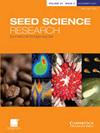Seed ecology of post-fire flowering species from the Cerrado
IF 1.9
3区 生物学
Q2 PLANT SCIENCES
引用次数: 0
Abstract
Abstract Post-fire flowering (PFF) species resprout, flower and disperse seeds within weeks after fire. This may be an important strategy to recruit new individuals and colonize the gaps opened by fire. The seeds released in the post-fire environment may interact with byproducts derived from plant burning, and the resulting ash may have compounds that can promote the germination of various seeds, particularly those with permeable coats. In the Cerrado ecoregion, PFF is a strategy commonly observed in the species of the ground layer, but their seeds are rarely investigated. So, we examined the quality and the germination of the seeds of 13 species that disperse seeds within 3 months after fire. We estimated the amount of empty, filled and predated seeds for each species, and tested the germination with or without ash. There was a clear separation in seed quality as dicots produced 35–75% filled seeds but grasses <15%. Pre-dispersal predation was only observed for dicots (<10%). Ash stimulated the germination of two out of the three dormant species but inhibited the germination of three non-dormant species. Overall, the seeds produced in response to fire are an important source of genetic variability in an ecosystem that has resprouting as the main persistence strategy. As most species have non-dormant seeds, ash may only be important to stimulate the germination of few PFF species. Even so, ash can be completely washed away by rains before seeds are dispersed and may not have an effect under field conditions.塞拉多火灾后开花物种的种子生态学
摘要:火后开花(PFF)植物在火灾后数周内重新发芽、开花和散布种子。这可能是一种重要的策略,可以招募新的个体,并在炮火打开的缝隙中殖民。在火灾后的环境中释放的种子可能与植物燃烧产生的副产品相互作用,产生的灰可能含有可以促进各种种子发芽的化合物,特别是那些具有透水性外壳的种子。在塞拉多生态区,PFF是一种常见于地面层物种的策略,但它们的种子很少被调查。因此,我们检测了13种在火灾后3个月内传播种子的种子的质量和发芽情况。我们估计了每个物种的空种子、满种子和提前种子的数量,并测试了有无灰的发芽情况。在种子质量上存在明显的差异,双科植物的饱满率为35-75%,禾草的小于15%。分散前捕食现象仅见于双斑蝽(<10%)。灰对三种休眠树种中的两种萌发有促进作用,对三种非休眠树种萌发有抑制作用。总的来说,在以再生为主要持续策略的生态系统中,对火灾做出反应的种子是遗传变异的重要来源。由于大多数物种都有非休眠种子,灰分可能只对刺激少数PFF物种的萌发有重要作用。即便如此,在种子传播之前,灰烬可以被雨水完全冲走,并且在田间条件下可能不会产生影响。
本文章由计算机程序翻译,如有差异,请以英文原文为准。
求助全文
约1分钟内获得全文
求助全文
来源期刊

Seed Science Research
生物-植物科学
CiteScore
3.60
自引率
4.80%
发文量
23
审稿时长
>12 weeks
期刊介绍:
Seed Science Research, the official journal of the International Society for Seed Science, is a leading international journal featuring high-quality original papers and review articles on the fundamental aspects of seed science, reviewed by internationally distinguished editors. The emphasis is on the physiology, biochemistry, molecular biology and ecology of seeds.
 求助内容:
求助内容: 应助结果提醒方式:
应助结果提醒方式:


